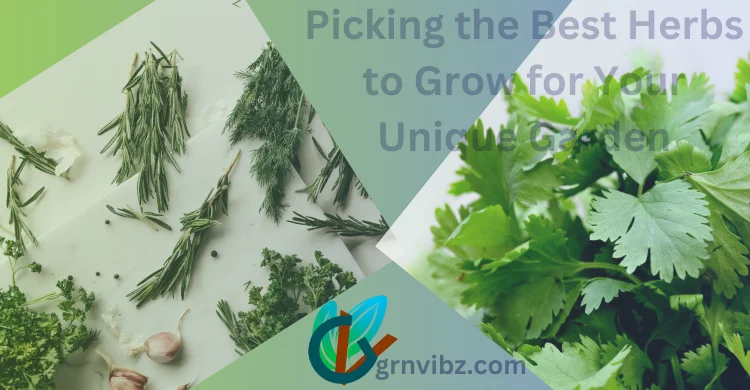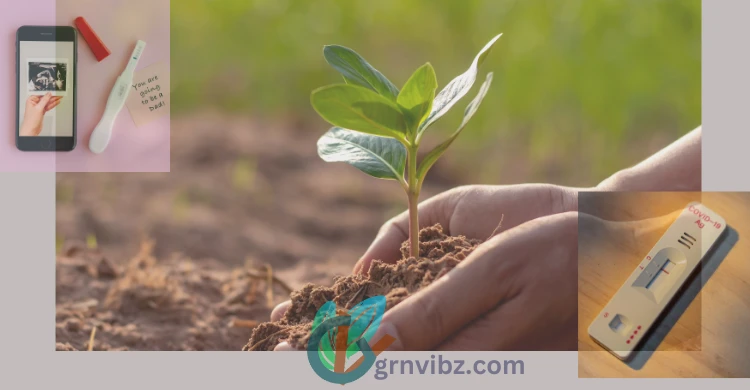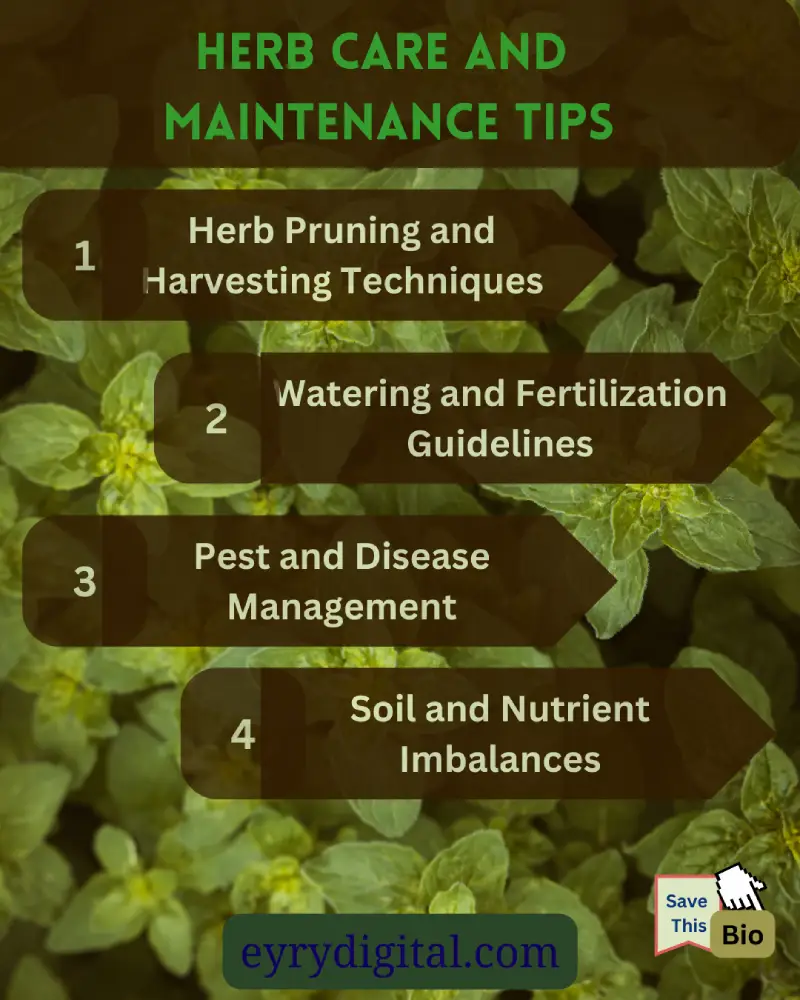Picking the Best Herbs to Grow for Your Unique Garden

A great choice you selected when you decided to venture into the world of herb gardening. Herb planting is truly magical whether it’s for crafting home/herbal remedies or spicing up your dishes. In the United States, more than half of citizens (55%) were involved in gardening activities in 2021. But the most essential step to consider before starting planting is choosing the best herbs to grow for your specific garden.
In this guide, you will learn how to select the best herbs that not only survive but thrive in your home garden. You will explore how to evaluate factors like soil quality, sunlight, and climate. Also, you will be able to match the best herbs with your culinary preferences and add that aesthetic touch. So, grab your gardening gloves, and let’s embark on this green journey together.
Understanding Your Garden’s Unique Conditions
Before we dive headfirst into herb selection, it’s essential to get acquainted with your garden’s distinct characteristics. Every garden is unique, and understanding these conditions will set the stage for a successful herb garden.
Sunlight Requirements
The amount of sunlight your garden receives is a pivotal factor in determining which herbs will flourish. Most herbs fall into one of these categories:
- Full Sun: These thrive best in 6-8 hours of direct sunlight daily. Some of the common examples are basil, rosemary, and lavender.
- Partial Shade: Herbs like cilantro, mint, and parsley will do well with 3-6 hours of sunlight per day.
- Shade: A few herbs, like chives and lemon balm, can thrive in partial to full shade, making them suitable for gardens with limited sun exposure.
To get good results evaluate your garden’s sun patterns throughout the day and choose the best herbs that match those conditions. Otherwise, herbs with insufficient sunlight may become leggy and less flavorful.
Soil Quality and Composition

Soil health is the foundation of a successful herb garden. Give time to assess your garden’s soil composition, quality, and other key features:
- pH Levels: Most herbs grow well in slightly acidic to neutral soil (pH 6-7). You can test your soil’s pH with a simple kit available in your garden store.
- Drainage: Good drainage is essential to prevent overwatering. To improve drainage either raise beds or amend the soil with organic matter.
- Soil Texture: Well-draining loamy soil is ideal for most herbs. Sandy soils drain quickly, while clayey soils retain water. You can test your soil’s texture with a simple kit and amend it to create the right texture.
AI209-T; pH Tester Combo Kit
Get the top-rated pH tester (AI209-T) with a calibration and probe care combo kit, including a cleaning brush and Apera’s CalBox for organized solution storage
Luster Leaf 1602 Soil Kit, 20 Tests
Innovative, affordable soil test kit with quick at-home results for pH, Nitrogen, Phosphorus, and Potash covering multiple spots in your yard or garden
Climate and Weather Considerations
Different herbs thrive in various climates, so it’s essential to know how your local weather patterns impact herb growth. Factors to consider include:
- Hardiness Zones: Check your USDA hardiness zone to determine which herbs are suitable for your region. Herbs like thyme and oregano are hardy and can withstand cold winters.
- Microclimates: Your garden might have microclimates with slightly different conditions. For example, a south-facing wall can create a warmer microclimate, allowing you to grow herbs that need more heat.
With clear information about your garden’s conditions, you’re ready to move on to the next step: choosing the best herbs.
USA Plant Hardiness Zone
Explore your local climate with the USA Plant Hardiness Zone Map in a 24×36-inch size
House of Doolittle Write On
Also, known as Wipe off Laminated United States Map is a durable laminated surface for long-lasting, reusable writing, perfect for classrooms, and offices
Temperature Sensor 608H1
Temperature Sensor/Testo Moisture is a compact thermometer that measures 90x40x111mm, 0.16kg
How to Choose the Best Herbs for Your Unique Garden

Now that you’ve assessed your garden’s conditions, it’s time to choose the best herbs that not only survive but thrive in your home garden. Here are some key metrics that need consideration while choosing the best herbs are
1. Selecting The Best Herbs Based on Garden Size and Layout
Now that you’ve assessed your garden’s conditions, it’s time to consider its size and layout. The size and layout of your garden are crucial factors for herb selection because they can ensure harmony and efficiency.
Container Herb Gardens
When you have space issues container herb gardening offers a versatile and compact solution. You can grow herbs in pots, window boxes, hanging baskets, or even recycled containers. Container gardening is ideal for:
- Balconies and Patios: Apartment dwellers can enjoy a thriving herb garden without a backyard.
- Herbs with Different Requirements: Containers allow you to cater to each herb’s specific needs, making it easier to grow a variety of the best herbs in a small space.
- Mobility: You can move containers to optimize sunlight or protect herbs from harsh weather conditions.
Make sure to select containers with drainage holes to prevent waterlogged roots. Consider the best herbs like basil, chives, and thyme for your container garden; they adapt well to confined spaces.
Indoor Outdoor Plant Pot
HC Companies 12 Inch Eclipse Round Planter with Saucer – Versatile, Contemporary White Pot for Flowers, Vegetables, and Herbs, Ideal for Indoor and Outdoor Use
iPower 5 Gallon Heavy Duty Grow Bags
iPower 5 Gallon Aeration Grow Bags: 10-Pack of Durable Nonwoven Pots, 14″ Diameter, Environmentally Friendly & Reusable
iPower 30 Gallon Grow Bags
iPower 30 Gallon Grow Bags: 20-Pack of Tough Nonwoven Plant Containers with Handles for Easy Garden Planting. Cool and Mosquito-Resistant Tan Design.
In-Ground Herb Beds
When you have a sufficient area for gardening create in-ground herb beds.
In-ground beds offer more space for herb varieties and can be visually appealing with the right design. Here’s what you need to know:
- Bed Location: Choose a location that aligns with your garden’s soil conditions and sunlight.
- Spacing: Design the layout carefully, leaving enough space between herbs to encourage airflow and prevent overcrowding.
- Edging and Borders: Define your herb bed with edging materials like stones, bricks, or decorative borders.
In-ground herb beds are ideal for growing a wide range of herbs, including perennials like sage, thyme, and oregano. They can be arranged in clusters or rows, or even follow geometric patterns for a visually pleasing effect.
Vertical Herb Gardens
If you have limited horizontal space or want to add an artistic touch to your garden, think of vertical herb gardens.
Mr. Stacky 5 Tier Stackable Verticle Planter
Mr. Stacky’s 5-Tier Vertical Planter: Grow more with less water. Ideal for both Indoor and outdoor strawberries, herbs, flowers, and Vegetable
Mayne Fairfield 3ft Window Box
Durable, year-round window boxes crafted from high-grade Polyethylene resin with built-in UV protection for long-lasting beauty
SuperMoss (29211) Hanging Basket
Elevate your garden with SuperMoss MossWeave Hanging Basket. This 12.5″ square basket in fresh green is a durable, beautiful choice for hanging plants.
These gardens utilize vertical structures like walls, trellises, or fences to grow herbs. Here’s why they’re a fantastic choice:
- Space Optimization: Vertical gardens make the most of limited space, allowing you to grow the best herbs in unconventional areas.
- Aesthetic Appeal: Vertical gardens can be visually stunning, creating a living wall of greenery in your garden.
- Easy Access: Herbs are within arm’s reach for harvesting and maintenance.
To create a vertical herb garden, select herbs with trailing or cascading growth habits, such as mint, thyme, and nasturtium. Install a sturdy support structure and ensure proper irrigation for your herbs to thrive.
2. Matching Herbs to Culinary Preferences
Now that you’ve set the stage for your herb garden, it’s time to focus on your culinary preferences. After all, many of us embark on this herb gardening journey to elevate our cooking. Let’s explore how to select the best herbs that cater to your taste.
Popular Culinary Herbs
Before diving into specific dishes or themes, it’s essential to familiarize yourself with some staple culinary herbs that can elevate a wide range of dishes:
- Basil: This aromatic herb adds a fresh, slightly peppery flavor to Italian dishes, salads, and pesto.
- Rosemary: Known for its robust flavor, rosemary pairs well with roasted meats, potatoes, and bread.
- Parsley: A versatile herb used as a garnish, parsley adds a bright, fresh flavor to various dishes.
- Thyme: With a subtle earthy flavor, thyme complements soups, stews, and roasted vegetables.
- Mint: Mint leaves are perfect for making refreshing beverages, and desserts, and pairing them with lamb.
These culinary classics are excellent starting points for any herb garden. But to truly customize your garden, consider your favorite cuisines and dishes.
Creating Themed Herb Gardens
If you have a specific cuisine or type of dish you adore, why not create a themed herb garden? Themed gardens focus on herbs that are commonly used in a particular culinary tradition. Here are a few ideas:
- Italian Herb Garden: Grow basil, oregano, rosemary, and thyme for authentic Italian flavors in your pasta and pizza dishes.
- Thai Herb Garden: Thai cuisine relies on herbs like lemongrass, Thai basil, and cilantro for that distinctive zing.
- Mediterranean Herb Garden: Create a Mediterranean paradise with rosemary, oregano, sage, and lavender for savory, aromatic dishes.
- Mexican Herb Garden: Plant cilantro, oregano, and epazote to add that Mexican flair to your salsas, tacos, and guacamole.
- Tea Herb Garden: If you’re a tea enthusiast, grow the best herbs like chamomile, mint, and lavender for a soothing cup of herbal tea.
By tailoring your herb selection to your culinary interests, you can elevate your home-cooked meals to restaurant-quality standards.
3. Incorporating Aesthetic Appeal
While the primary goal of your herb garden may be practical, it’s essential not to overlook aesthetics. Fresh herbs can be both functional and visually appealing, enhancing the overall beauty of your garden space.
Herb Companion Planting for Visual Appeal
Companion planting involves strategically placing herbs alongside other plants to enhance their growth or deter pests. In terms of aesthetics, herb companion planting can create stunning combinations in your garden. Here are some ideas:
- Herbs with Flowers: Pair herbs like lavender, chamomile, or bee balm with colorful flowers to create a visually pleasing contrast.
- Contrasting Foliage: Combine herbs with different foliage textures and colors to add depth and interest to your garden.
- Herb Borders: Use low-growing herbs like thyme or oregano to create neat borders around garden beds.
Herb Garden Design Principles
Creating an aesthetically pleasing herb garden involves considering design principles. Here are some tips to help you design a visually appealing herb garden:
- Symmetry and Balance: Achieve balance by placing herbs and garden features symmetrically.
- Color Coordination: Coordinate herb colors to create harmonious compositions. For example, purple basil next to green sage can be visually striking.
- Height Variations: Arrange herbs by height, with taller herbs at the back and shorter ones at the front, for a sense of depth.
- Focal Points: Add eye-catching elements like decorative pots, garden sculptures, or a central focal point.
By applying these design principles, you can create a herb garden that’s not just functional but also a delight to behold.
4. Herbs for Medicinal and Wellness Purposes
Herbs aren’t just for culinary and aesthetic purposes; they also have a rich history of medicinal and wellness uses. Adding medicinal herbs to your garden can provide you with natural remedies and holistic well-being.
Medicinal Herb Selection
Now it is time to analyze some medicinal herbs and their unique healing effects:
- Lavender: Famous for its soothing aroma, lavender relieves stress and elevates relaxation. It’s also used topically for skin irritations.
- Echinacea: Commonly used the immune disorders and cold symptoms.
- Calendula: This herb is prized for its anti-inflammatory properties and is used in salves and creams for skin issues.
- Chamomile: Renowned for its calming effects, chamomile tea can help with insomnia, anxiety, and digestive discomfort.
- Aloe Vera: Used topically for soothing burns and skin irritations.
Including these medicinal herbs in your garden not only adds a therapeutic element but also connects you with age-old herbal traditions.
5. Herb Gardens for Relaxation and Stress Relief
In today’s fast-paced world, finding moments of relaxation and stress relief is essential. Your herb garden can be your personal oasis for tranquility and well-being. Here’s how:
- Meditation Space: Create a designated area within your garden for meditation and mindfulness. Use the best herbs like lavender, chamomile, and lemon balm to enhance the calming ambiance.
- Herbal Baths: Harvest and dry herbs like rosemary, mint, and sage to create herbal bath blends for a soothing soak.
- Aromatherapy: Extract essential oils from herbs like lavender and rosemary to use in aromatherapy diffusers or homemade candles.
By integrating relaxation and wellness into your herb garden, you can reap both physical and mental health benefits.
Herb Care and Maintenance Tips

Now that you’ve carefully selected the best herbs that match your garden’s conditions, culinary preferences, and aesthetics, it’s crucial to understand how to care for them to ensure their well-being and productivity.
Herb Pruning and Harvesting Techniques
Proper pruning and harvesting practices are vital to maintain healthy herb plants. Here are some essential tips:
- Regular Pruning: Pinch or trim herbs to encourage bushy growth and prevent legginess. Remove any dead or yellowing leaves.
- Harvesting Timing: Herb harvesting at the right time is a crucial process, especially for medicinal ones. Harvest herbs when they’re at their peak flavor and aroma, usually in the morning after the dew has dried but before the midday sun intensifies.
- Preserve Freshness: Store harvested herbs in an airtight container or freeze them to retain their flavor and fragrance.
Fiskars Bypass Pruning Shears
Fiskars 5/8″ Bypass Pruning Shears: Precision cutting for healthier plants with non-slip grip and self-cleaning design
Cordless Handheld Grass Cutter Shears
SereneLife Cordless Handheld Grass Cutter Shears: 2-in-1 blades for precision trimming and convenience. Lightweight, rechargeable, and easy to switch between grass and hedge cutting.
SereneLife Grass Shear Cutter-PSLHTM20
SereneLife Grass Shear Cutter: Lightweight, Cordless, Rechargeable – Easily trim grass and leaves with this 3.6V handheld trimmer
Watering and Fertilization Guidelines
The way you water and feed your herb garden can significantly impact its health and productivity. Here’s what you need to know:
- Watering: Herbs generally prefer to dry out slightly between waterings. Water deeply but less frequently, and aim to water at the base of the plant to prevent foliage diseases.
- Mulching: Applying mulch around your fresh herbs can help conserve moisture, regulate soil temperature, and reduce weeds.
- Fertilization: Fresh herbs are not heavy feeders. Use a balanced, organic fertilizer sparingly, or opt for compost to provide essential nutrients.
Orbit 24639
WiFi Smart Hose Timer: Auto herb watering, adapts to local drought
Rachio 3
Rachio 3: Smart Sprinkler Controller with 8 Zones. Tailors watering saves water with weather intelligence. No monthly fees
Cordless Pruning Shears
Effortless Cordless Pruning Shears with 6ft Reach – Trim Bushes, Roses, and Branches Easily. Rechargeable, Cuts up to 0.98″ – Perfect for Gardens!
Pest and Disease Management
Pesky pests and troublesome diseases can affect your herb garden. Here’s how to handle them:
- Companion Plants: Use companion plants that deter specific pests. For instance, marigolds can deter aphids and nematodes.
- Natural Remedies: Explore organic pest control methods, such as neem oil for aphids or garlic spray for fungal diseases.
- Pruning and Hygiene: Regularly prune and remove diseased or infested plant parts to prevent the issue from spreading.
Soil and Nutrient Imbalances
Soil issues can manifest in various ways, affecting herb growth. Here’s how to identify and rectify soil problems:
- Soil Testing: Conduct regular soil tests to monitor pH levels and nutrient content. Adjust soil amendments accordingly.
- Crop Rotation: Practice crop rotation to prevent soil depletion and nutrient imbalances.
- Compost and Organic Matter: Continuously enrich your soil with compost and organic matter to improve its structure and fertility.
By staying vigilant and addressing issues promptly, you can maintain a healthy herb garden throughout the growing season.
FX14690 -Organic Plan Fertilizer
Boost your tomato and veggie garden with FoxFarm Happy Frog Soil Mix. Prevent diseases with calcium and enrich with organic ingredients. Ideal for a thriving, organic harvest
Malibu Compost
Elevate your garden with Malibu Compost Bu’s Blend Compost – 6 Qt. A 100% organic boost for your soil’s health and your plants’ vitality
Hailo Compact-Box M Built-in Pull-Out Waste Bin
Hailo Compact-Box M: Smart, hygienic, and easy. This German-made pull-out waste bin offers a 15-liter capacity, automatic lid lift, and simple installation for cabinets starting at 15.7 inches. Keep your space clean and organized effortlessly
Personalizing Your Herb Garden Journey
As you embark on your herb gardening journey, remember that your garden should reflect your unique preferences and aspirations. Your herb choices, garden design, Herb cultivation methods, and herb maintenance routines should align with what brings you joy and satisfaction.
Consider adding personal touches to your garden:
- Herbs with Personal Significance: Grow herbs that have personal meaning or cultural significance to you or your family.
- Garden Decorations: Add decorative elements like wind chimes, garden art, or stepping stones to make the garden uniquely yours.
- Herb Markers: Create custom herb markers with your own designs or messages to add a personal touch to your garden beds.
Your herb garden should be a source of pride and enjoyment, so don’t hesitate to infuse your personality into every aspect of it.
